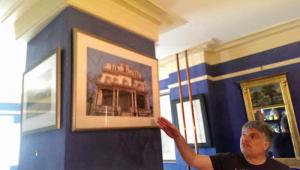April 24, 2014
 Steven Dimeo in his Lower Mills dining room. Photo by Gintautas Dumcius
Steven Dimeo in his Lower Mills dining room. Photo by Gintautas Dumcius
It’s 9:30 on a crisp Friday morning in March, and Steven Dimeo is talking excitedly about gutters on Jones Hill. Bear with him:
“The gutter is very important because it has an extreme mechanical function, to take water away from the eave,” he says, as he makes his way around a grand Victorian home on Cushing Avenue, its front covered in scaffolding. “And it has an even more extreme architectural function, which is to throw shadow in light and, in classically derived architecture, we are really trying to imitate a face.”
He looks up and proudly points to the gutter’s decorative ledge before continuing his amble around the property while pointing out the areas his crew had fixed up. Dimeo has been working on this house, perched on a steep slope, for seven years. He redid the chimney and he plans to fix up the skylight as part of another job.
Dimeo heads up Classical Details, a small historical home improvement and restoration company based in Lower Mills that focuses on millwork and wood and copper gutter systems. The company works on 10 to 12 homes a year.
Dimeo, who grew up in Weston, left school in ninth grade and lit out for the state of New York, where he took apart barns and hop houses. “I would find buildings in the woods,” he says, “and the question I asked myself was how do these things in their decrepitude have a latent glory which is indescribable and incredible?” He then adds, matter-of-factly, “At that point, I smoked a little pot.” He learned gravestone-carving and wagon wheel-making. At night, he would drive around in a Fiat, looking at old houses.
“See the little crown molding?” he says, pointing at the Jones Hill house. He had repaired the shingling and installed copper screens. Everything came together with the crown molding. Dimeo points to a smaller red home next door. He’s been working on that home, too. The gutter on its left is copper and it’s new, he says. He has a $150,000 budget to work with on the first home, and an $80,000 budget on the second.
Then it’s up the rickety scaffolding for the two of us, every step letting out a creak as we make it to the top. Dorchester is below, and the UMass Boston campus, on Dorchester Bay, is in the distance. He asks his visitor if he has a camera. “You want to get shots of this eyebrow window,” he says.
Dimeo had always wanted to live in Dorchester, drawn to its diverse mix of architecture. Five years ago he bought a home on Rugdale Road in Lower Mills. It serves as his office, too.
A German farm truck, originally made for tilling and harvesting, which Dimeo found in Central Massachusetts, is in the driveway. Inside, each room is filled with pieces of wood and books on architecture, mixed in with tomes on Churchill and the Civil War. A standard Victorian cornice sits in one corner, next to a Greek revival mantel from Galveston, Texas, which he is trying to copy with his tools. A Federal-era mirror he found in New York is hanging in an alcove. “I have here a pretty good laboratory,” he says.
The home appears to be in a constant state of construction inside. One room is dedicated to boxes of different handrail and gutter sizes. There’s a three-by-four gutter for a Victorian and one that he found in an 1840 home in Concord, Mass.
A sheet metal shop owner from the other side of town comes into the house, and Dimeo offers him a piece of the fish he is frying in the kitchen. “Cut it in half,” he says. “Just for a few minutes and then we’re going to the South End.” A small birthday cake sits on the counter – Dimeo is turning 56 that day.
He goes up to the top floor, noting that the room looks as it would have in 1840: Small and a bit cramped, but livable. His coppersmith crashes up there. “The plaster’s brand new and it feels just like a baby’s ass,” he says.
Back to the Concord gutter. He is able to compare what he finds with what he has in his books. “It’s like archeology and forensics,” he says. “In order to understand history, you know, Roman history, we study Roman history. But the great thing about American architecture is that we can actually find things in situ – in place, and recreate it.”
He goes back into the kitchen for a bite of fish while a co-worker waits outside in the car. “I’ll be out in just a minute,” Dimeo says, and then he lingers, surrounded by his faces.



